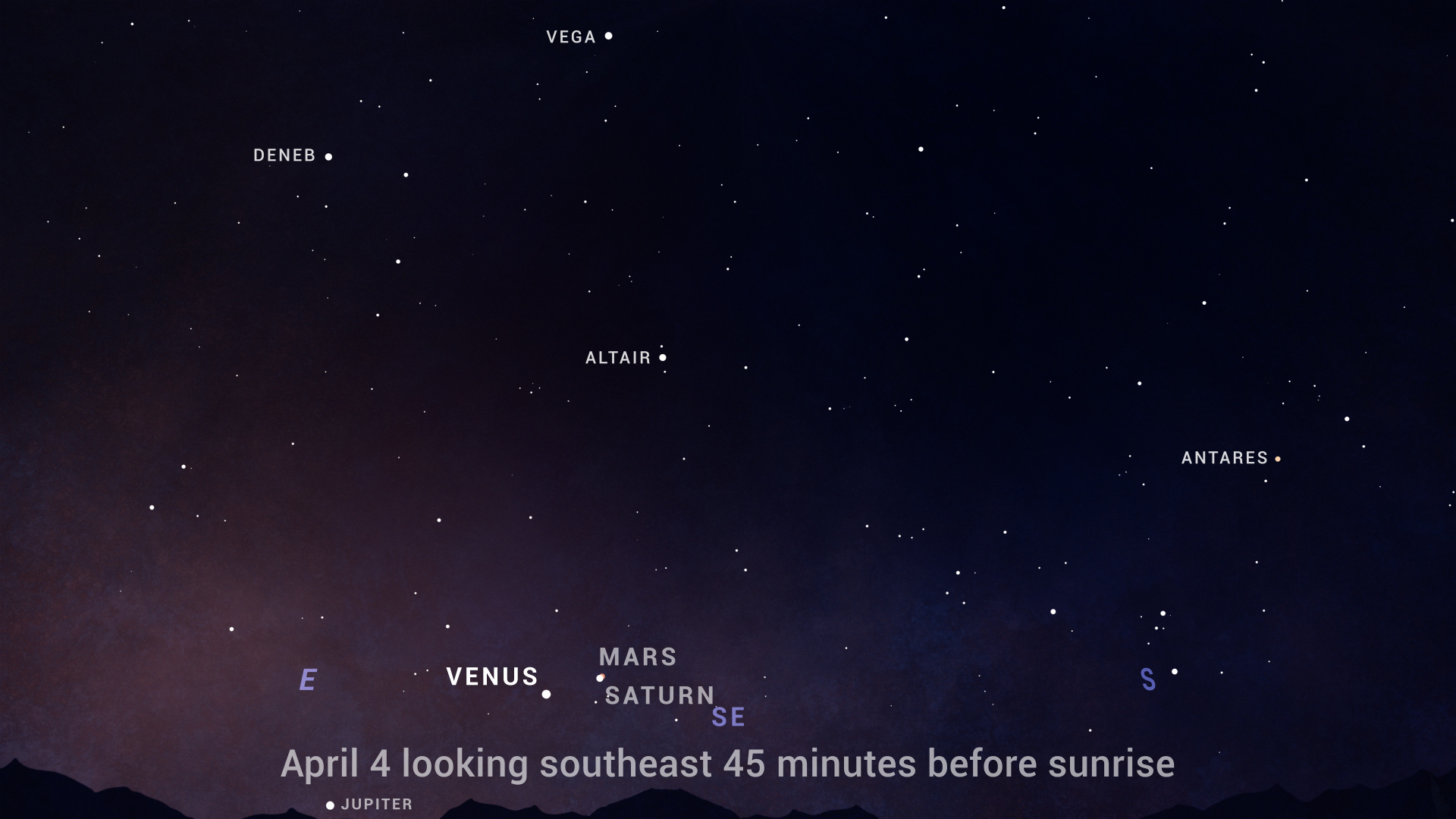See Venus, Saturn and Mars shine close before sunrise this week
Look to the southeast on Monday and Tuesday (April 4 and 5) to catch the show.

You can watch three worlds practically hug each other in the night sky Monday and Tuesday (April4-5) if you get up a little early.
Cloudy Venus, bright Mars and ringed Saturn will all get together again in the southeast predawn sky after forming a celestial triangle in late March.
NASA notes that Mars and Saturn were only a couple of finger widths apart on Friday (April 1), but will be even closer by Monday.
"By the 4th, Saturn and Mars are separated by less than the width of the full moon. Saturn then moves on, increasing its separation from Mars each day," the agency said in a statement. You can best catch the show at roughly 5:50 a.m. EDT in New York City, which is about 45 minutes before dawn.
If you're looking for binoculars or a telescope to see planets in the night sky, check out our guides for the best binoculars and best telescopes. If you need photography equipment, consider our best cameras for astrophotography and best lenses for astrophotography to prepare for the next planet sight.
Related: The brightest planets in the night sky: How to see them (and when)
If you take a photograph of the planets, let us know! You can send images and comments in to spacephotos@space.com.
You can also see the planets moving a bit between Monday and Tuesday. On Tuesday, Saturn and Mars will reach their closest approach to each other, at only half a degree apart. (Mars will be shining redly, below the white-yellow Saturn.)
Get the Space.com Newsletter
Breaking space news, the latest updates on rocket launches, skywatching events and more!
Venus will also be visible, NASA said, to the lower left of Saturn and Mars. "Venus will rise last above the east-southeastern horizon at 4:54 a.m. EDT, and will be about 10 degrees above the horizon as morning twilight begins about an hour later at 5:48 a.m.," the agency stated.
Besides the planetary show, there's a lot more to see in the night sky. On Monday, the bright Pleiades star cluster will be only five degrees to the upper right of the waxing crescent moon.
While the star cluster is visible with the naked eye, that will depend on how much light pollution interferes with the view. "You may need binoculars to really appreciate this star cluster," NASA said.
Then on Tuesday, watch for the bright star Aldebaran, about seven degrees to the lower left of the moon. The star is the bulls-eye of Taurus, the bull constellation. (The names may vary depending on which culture you follow; here, we are referring to the official designations by the International Astronomical Union.)
Planetary and lunar alignments are common because all of these worlds orbit in the same approximate plane of the solar system, known as the ecliptic. Even if you don't quite catch the worlds aligning, the three planets will still be bright in the coming days and give you a great view.
Editor's note: If you capture a stunning photo of the planets and would like to share it with Space.com for a story or gallery, let us know! You can send images and comments in to spacephotos@space.com.
Follow Elizabeth Howell on Twitter @howellspace. Follow us on Twitter @Spacedotcom or Facebook.
Join our Space Forums to keep talking space on the latest missions, night sky and more! And if you have a news tip, correction or comment, let us know at: community@space.com.

Elizabeth Howell (she/her), Ph.D., was a staff writer in the spaceflight channel between 2022 and 2024 specializing in Canadian space news. She was contributing writer for Space.com for 10 years from 2012 to 2024. Elizabeth's reporting includes multiple exclusives with the White House, leading world coverage about a lost-and-found space tomato on the International Space Station, witnessing five human spaceflight launches on two continents, flying parabolic, working inside a spacesuit, and participating in a simulated Mars mission. Her latest book, "Why Am I Taller?" (ECW Press, 2022) is co-written with astronaut Dave Williams.









